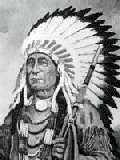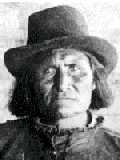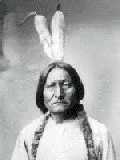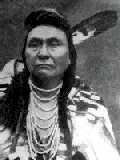Native History
European Descendants 
Possibly thousands of years before any white man set foot on the Great Plains, the area was inhabited by several Native American nations. The nations were descendants of early Europeans that migrated across the Bering Strait by foot, eons before modern civilization developed in Europe. All nations did not descend from one migratory crossing. Instead, at several times, more migrations crossed the same passages and developed into entirely different cultures or what eventually became known as nations.
The migrations didn't stop in the Great Plains area of course, they continued on south to Tierra del Fuego. South American natives developed into powerful, sophisticated cultures that we still have trouble fully comprehending even today. As sophisticated as they were, they were no match for Spanish explorers carrying diseases that they had not developed a natural immunity to, and even worst, when entire communities were wiped out by the Spaniards using force. The explorer's journals tell of eliminating large communities and leaders. This led to the eventual end of some of these civilizations as the remainder fled, joined other native civilizations peacefully, some being captured as slaves to other native civilizations, and some, without leadership or size to sustain reproduction levels to sustain them, eventually died out.
Our North American natives, also developed sophisticated civilizations. Several of these civilizations died off or descended into different cultures through merging, capture and slavery by rival societies, disease and reduction of sufficient numbers to sustain the culture or nation. Some left their mark more prominently than others, some hardly at all. Some remains of the “mound people” of Iowa was all that was left when white man encountered the modern natives that ranged the Great Plains. The French and Spanish explorers carried diseases that they had developed an immunity to that the natives had not. When the two met and mingled, these diseases were passed on.
By the time of the Lewis and Clark expedition, natives of North and South America were not a lot different in the sense of sophistication, however, there were great differences in lifestyles.
In Search of Native Wealth
Spanish 
When the Spanish landed in South America (1500s), they brought their own ideals, disease, and cultures. They also brought something else, a desire for riches, and gold was at the top of the list. Gold was universally recognized as a non-corrosive, rare, and therefore special metal. It was a commodity in the Americas the same as it was in Europe. The search was on.
The Spaniards landing in South America found riches, however, it belonged to the natives. These Europeans took what they wanted, killing any natives that resisted or stood in their way. The Spaniards were a nuisance to natives at the very least yet there was no chance of asking them to leave and expect results.
North America was free of such encounters until Coronado* arrived in the southwest around 1541. Traveling on borrowed money (from the wife), he had to return with the undiscovered bounty from the north. In search of the Seven Cities of Cibola, Coronado was accompanied by 2,000 soldiers. Possessing questionable information, unknowingly, Coronado was convinced his future was looking bright. It was not to be as he wished. In the wake, he had attacked North America, at the time inhabited only by Natives. Read more on Coronado's attack
The Spanish approached the Midwest from two different directions. Hernando de Soto started in Florida, then worked his way into the southern parts of North America. He made it past the Mississippi in 1541 and even explored upstream some distance, some speculating that he may have discovered where the Missouri River joined the Mississippi and traveled upstream, possibly as far as the Kansas Nebraska region. Regardless of how far he made it, he wasn't immune to disease, fell sick, and subsequently died while still exploring. His body was buried at sea, the sea in this case being the Mississippi River. His followers returned home reporting what they found but without the gold.
French 
The French explorer Sieur de La Salle* approached the Midwest from the south around the Louisiana area in the 1680s. La Salle also laid claim to the lands and named it Louisiana in honor of the king of France, Louis XIV.
In spite of the fact that the natives were the true owners of the land, it was now claimed by both the French and the Spanish explorers. The French had it, lost it, and got it back during the French and Spanish wars.
The Paris Treaty of 1803, which allowed for the Louisiana Purchase of these lands from the French, didn't solve the native's problems. Forced to fight for their homeland with the onset of more and more intruders of lighter skin, the natives were soon reduced to living on reservations. Often pooled together with rival nations in close quarters, those tribal grievances subsided due to the more major universal concern of regaining the freedom of the wild. That time hasn't come yet.
Horses 
As we all know from our Cowboy movie education, Indians rode horses bareback, and far better than any white man could ever dream of. The movies rarely show natives moving from one location to another using dog power (the energy source used before horses), to pull tent poles loaded with goods. Our experience is based on the skills observed when settlers headed west. By that time, the natives had become experienced horsemen. The earliest record of natives on horseback is from the 1570s, way before the era covered by western movies.
Until the Spaniards arrived, the North American natives had never encountered horses.* The fastest animal of that size previously was the mighty buffalo (actually bison), which took cunning and skill to sneak up on to bring down.
In the John C. Ewers book Plains Indian History and Culture: Essays on Continuity and Change, he tells how the natives were afraid of Coronado's conquistadors on horseback but impressed never-the-less. Ewes reports that in 1730, a Plains Cree recalled his nation's first encounter with a dying horse. “A number of us went to see him, and we all admired him. He put us in mind of a stag that lost his horns, and we did not know what name to give him. But as he was a slave to man, like the dog, which carried our things, he was named the Big Dog.”
More often than not, the Spaniards came out on top in skirmishes, however, some resulted in total or near total losses due to a smaller Spanish exploration party being outnumbered. In these cases, the Spanish were not able to retreat with all the bodies or with all the horses. These captured horses were the first acquired by the natives, who became expert riders arguably unparalleled by any other since. Some horses were not captured; there are places in the southwest where their descendants have continued to live free since the 1500s.
The horse drastically changed the life of the natives. Bison were a resource requiring no upkeep, natives only had to keep up with the bison. Now, the natives had an animal that helped them keep up with the bison, but they also had an animal that they had to take care of, such as feeding, breeding, and keeping track of a valuable commodity. Hunting bison became a much easier task. When the natives moved camp, the horse replaced the dog in pulling supplies. The horse could pull the same load that had required 5 dogs before. Soon the native's wealth was measured in horses.
The White Man Cometh
Open Arms 
By the 1800s, Native American nations in North America had stabilized for the most part. There were some rivalries among nations over lands or local disputes sometimes coming down to personalities of leaders, but mostly, all nations belonged to the same civilization or culture of North American Native nations. The Great Plains is often thought of as a constant war among native nations and between natives and the settlers. Simply not true. The natives got a bum rap due to sensationalized reporting, and because we see it all condensed into one period. For the most part, the natives were a docile peaceful people no different from what we consider our modern civilizations to be. We certainly cannot claim any bragging rights along these lines. That is not to say there were no problems. There were many, too many. How many is too many when someone is taking your lands?
Our civilizations today are constantly in battle over borders or beliefs somewhere in the world. The frequency of native differences were no more than what we have today. In Europe where there are more nations in a smaller area, there seems to be more rivalries. American natives had different nations as neighbors also, and for the majority of the time they got along. They fought over the same things we do today, borders (thought of as hunting lands more than of property), and beliefs. Borders were usually shared as part of the land and sky. It was only when the cultures were so different between nations that shared a border that skirmishes broke out. When the light skinned explorers and trappers ventured into Indian country, they were met with open arms and gifts were exchanged, the gift exchange was a native custom. This is the way it was for a long time.
The first reports reaching Europe about North American natives mentioned how wonderful and peaceful they were. Europeans first arrived on the east coast in the 1500s, but the Great Plains area or Midwest wasn't settled until the 1800s (after the Louisiana Purchase). This means the natives had over two-hundred years of exposure to the fairer skinned folks settling down or passing through. More and more arrived, the numbers never went down; some nice, some thinking they were better than the Native Americans. Over a hundred years or so, it became common knowledge that the two were not alike. At first, the natives had no problem with that, but they thought differently than the Europeans, who considered themselves the cream of the crop of the hominoids; some of that comes across sooner or later. It was inevitable that resentment developed between the two cultures, especially since the fairer skin seemed to think they owned the land these people had lived on for thousands of years. I can't imagine modern man of any nation acting any differently to outsiders imposing their culture, rules, and going so far as to state where the original natives will have to live.
As the numbers increased, and the respect for the lands was not the same, and even the respect for the natives waned, anyone would start to stand up and say enough is enough. Naturally, some heated disagreements developed, finally to the point of battles. On their way back east, reports of these encounters got exaggerated with each retelling. When later put into print, one side was civilized, and the other were savages. Keep in mind which side was doing the reporting on paper, what ultimately ended up in the history books.
Exploration and Settler History 
The area closer to the Missouri River was not heavily populated with natives for a couple reasons. First, there wasn't a lot there. In the native's eyes, it wasn't all that desirable. The second reason was the water. The Missouri River was fast moving making it difficult to traverse with canoes compared to the slower waters of the Platte River. Faster moving waters such as the Missouri left sandbars in some spots and steep banks at its edges in other areas. Animals, especially larger ones such as the bison, lived closer on the plains on both sides of the Platte River. It is understandable that the natives also preferred to be near the better gamelands.
The natives were a little inland from the Missouri and the mouth of the Platte, but they did cover the area occasionally. If a campfire's smoke was visible near the river, there was a good chance that it would be investigated. As more and more fur trappers/traders ventured west of the Missouri, the campfires became more commonplace and since the fur traders posed no real threat, they were often ignored. Some fur trappers/traders bought, traded for, or were given native girls. The custom was to marry the native, and that very often meant that by accepting the women, you were then married. Some fur trappers/traders lived with the natives, even adopting native ways. After the Louisiana Territory purchase of 1803, there were several French fur trappers and traders that still mingled with the natives. The Lewis and Clark Expedition journal entry describing the first meeting with natives (near Ft. Calhoun) by Charles Floyd on August 2, 1804, states, “Capt. Lewis and Clark met them at Shakeing Handes we fired another Cannon thare wase 6 Chiefs and 7 men and one French man with them who has Lived with them for som yeares and has a familey with them” (spelling left and period omitted as in original journal entry).
After the Louisiana Purchase (April 30, 1803), a new history started with the explorers, Lewis and Clark, who came through the area on their way to the Pacific Northwest and back. Coming up the Missouri, Lewis and Clark first encountered natives in what was considered “Indian Country,” in the area west and north of the Missouri and Kansas borders. The first mention of a sign of Indians is seeing a dog at the edge of the river. It was assumed to be a dog that had been separated from its native owner. A journal reference made by Clark a short time later listing pets included “Indian dog” so it is assumed the same dog was collected.
When the Lewis and Clark Expedition reached the Omaha area, they were getting into more and more Indian country. It was decided that a meeting of peace explaining their purpose was in order. The first meeting with the natives was between the Omaha-Council Bluffs area and the Ft. Calhoun area. Keep in mind that at that point, the present day Council Bluffs didn't exist, much less Omaha or Ft. Calhoun as this was back in 1804. The meeting place was referred in the expedition journals in three variants of Council Bluff(s).
For the Corp of Discovery Expedition, language differences were overcome but was clearly a difficulty that needed to be solved. A solution was not had until the spring of the following year. Adding Toussaint Charbonneau, and one of his native wives (Sacagawea) to the expedition was a great help to communicating with other natives along the way. Toussaint being French, and understanding Hidatsa, and Sacagawea being born a native Shoshone, but kidnapped and brought into the Hidatsa culture, each being able to understand some part of other native languages, meant that together, they could translate back to the French speaking in the Expedition party, who could in turn communicate in English to the expedition leaders.
After the Expedition, and before the Mormons
After the expedition, the natives continued to live on their same lands. As settlers from the east moved west, lands west of the Mississippi were encroached upon. Eventually, the natives were driven west of the Missouri River. This meant that Iowa, Missouri, and parts of Minnesota were settled with the increasing number of palefaces. Over a period of 50 years, tensions were increasing when the natives were constantly told that the land belonged to the paleface and that the natives were only being “allowed” to continue to live there.
By 1845, the area east of the Mississippi, previously known as “Indian Territory” had been broken into states. The state of Illinois had rich fertile soils perfect for farming and rural pioneer life.
Iowa was being settled all the way to the Missouri River, mostly in the southern half with the overflow crossing over the Missouri River into what is now the state of Missouri.
Mormons were the earliest settlers 
The Mormons had left upper New York after being persecuted, settling in Ohio but still had some persecution problems. Moving to the area around Independence, Missouri was no better in terms of persecution. In search of a place that they would not be further persecuted, the church chose an area of swampland along the Mississippi. In this place they named Nauvoo, they drained the swamps, built homes, and planted crops. Soon they were persecuted once more. Their leader, Joseph Smith and his brother Hyrum were assassinated by a “lynch mob” The church continued to live in Nauvoo for two more years as things continued to deteriorate with neighbors. They again decided to move further west, leaving a town they had built from scratch.
The Mormons crossed the state of Iowa and arrived at the Missouri River with a dream but no home. They were now at the edge of Indian country. Beyond the Missouri was a place known to very few, they just had to get there. The west coast was owned by the Spanish, and its future would be decided by the Mexican War. Somewhere in between was a dream.
The Mormons needed a place to stay for the winter before continuing on. Against the Treaty of 1834, the U.S. Government made arrangements with the natives west of the Missouri, to allow them to camp on their lands for two years. Local nations at the time were the Omaha, Oto, Ponca, and Missouri Indians.
As spring approached, the Mormons started preparing, and started moving on to the west through the summer. The white man had been allowed to pass through to places beyond before; the fact that the white man was allowed to live west of the Missouri (especially settle for a couple years on Indian land) was a signal that the Great Plains were changing.
Our country was growing. The eastern states were starting to have their own problems. Economic issues were starting to separate the north and south on taxation, and the financial impact of freeing slaves. The Midwest and the lands beyond were the only place to escape the issues. The natives, now outnumbered were ready for a place they could call their own and not be hassled.
In 1854, the treaty ended with the natives, and a deal was made to cede their land and move to Kansas. Kansas-Nebraska was now a territory on its own. The territory was now open for settlement. Not all natives moved to Kansas and peaceful co-existence was beneficial to both sides. For the most part there weren't any problems. There was one exception that stands out, and that was the Pawnee War of 1859.
The war was the major topic of discussion in Omaha during the rest of the summer of 1859, the only other topic getting as much attention being the discovery of gold to the west. The Pawnee War turned out to be the last major uprising. A couple of years later, in 1861, Kansas was admitted to the union. In 1867 Nebraska followed suit. The natives were no longer in control. The natives would never regain ownership of these lands except in small parcels called reservations.
Continue Reading 
- Native Intro
- Native History
- Vásquez de Coronado's Attack on the Natives
- Sacagawea and the Lewis & Clark Expedition
- Native Nations Index
- Native Languages Tree
- Omaha Nation















